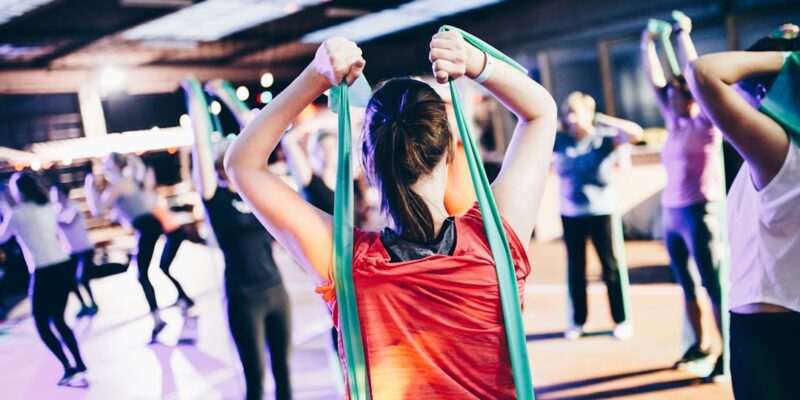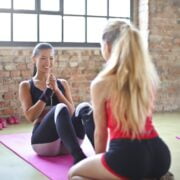
Get Sculpted: The Ultimate Upper Body Dumbbell Workout PDF for Toned Arms, Shoulders, and Back
Welcome to the ultimate upper body dumbbell workout! In this blog post, we will guide you through a comprehensive and effective workout routine that will help you sculpt and strengthen your upper body. Having a strong and well-defined upper body is not only aesthetically pleasing, but it also plays a crucial role in overall fitness and functionality.
Using dumbbells for upper body workouts offers numerous benefits. Dumbbells are versatile and can be used to target various muscle groups in the upper body, including the chest, shoulders, back, biceps, and triceps. They allow for a wide range of motion and provide stability and control during exercises. Additionally, using dumbbells engages stabilizer muscles, which helps improve overall strength and balance.
Key Takeaways
- The Ultimate Upper Body Dumbbell Workout is a comprehensive routine designed to sculpt and strengthen your upper body.
- A sculpted upper body not only looks great, but also improves posture, reduces risk of injury, and enhances overall fitness.
- Understanding the muscles involved in the workout, such as the chest, back, shoulders, and arms, is key to maximizing results.
- Choosing the right dumbbells for your fitness level is important to ensure proper form and prevent injury.
- Warm-up exercises, such as arm circles and shoulder rolls, are essential to prepare your upper body for the workout and prevent injury.
The Benefits of a Sculpted Upper Body
Having a sculpted upper body goes beyond just looking good. It has numerous physical and mental benefits. Physically, a strong upper body improves posture by strengthening the muscles that support the spine. This can help alleviate back pain and reduce the risk of injury. It also enhances overall functional fitness, making everyday tasks easier to perform.
Mentally, having a sculpted upper body can boost confidence and self-esteem. Achieving your fitness goals and seeing the physical changes in your body can have a positive impact on your mental well-being. It can also improve body image perception and promote a healthier relationship with your body.
Understanding the Muscles Involved in the Workout
Before diving into the workout routine, it’s important to understand the muscles that will be targeted. The ultimate upper body dumbbell workout focuses on the chest, shoulders, back, biceps, and triceps.
The chest muscles (pectoralis major and minor) are responsible for movements such as pushing and hugging motions. Strengthening these muscles can improve upper body strength and power.
The shoulder muscles (deltoids) are involved in various movements, including lifting, pushing, and rotating the arms. Strong shoulders contribute to overall upper body strength and stability.
The back muscles (latissimus dorsi, rhomboids, and trapezius) play a crucial role in maintaining good posture and supporting the spine. Strengthening these muscles can help prevent back pain and improve overall posture.
The biceps and triceps are the muscles of the upper arm. The biceps are responsible for flexing the elbow, while the triceps extend the elbow. Strengthening these muscles can improve arm strength and definition.
Choosing the Right Dumbbells for Your Fitness Level
| Weight Range | Fitness Level | Recommended Dumbbell Weight |
|---|---|---|
| 1-5 lbs | Beginner | 1-3 lbs |
| 5-10 lbs | Intermediate | 3-5 lbs |
| 10-20 lbs | Advanced | 5-10 lbs |
Choosing the right weight of dumbbells is essential to ensure an effective and safe workout. It’s important to start with lighter weights and gradually increase the weight as you build strength and endurance. Using weights that are too heavy can lead to poor form and increase the risk of injury.
To determine the appropriate weight, consider your current fitness level and the exercises you will be performing. As a general guideline, beginners can start with weights ranging from 5 to 10 pounds. Intermediate lifters can use weights between 10 to 20 pounds, while advanced lifters may opt for weights above 20 pounds.
Remember, it’s better to start with lighter weights and focus on proper form and technique. As you progress, you can gradually increase the weight to continue challenging your muscles.
Warm-Up Exercises to Prepare Your Upper Body for the Workout
Before starting any workout, it’s crucial to warm up your muscles to prevent injury and optimize performance. For the ultimate upper body dumbbell workout, it’s important to specifically warm up the muscles of your upper body.
Start with some light cardio exercises such as jogging or jumping jacks to increase your heart rate and warm up your entire body. Then, perform dynamic stretches that target the upper body, such as arm circles, shoulder rolls, and chest openers. These stretches help increase blood flow to the muscles and improve flexibility.
After the dynamic stretches, perform some light sets of the exercises you will be doing in the workout routine. This helps activate the specific muscles and prepares them for the upcoming workout.
The Ultimate Upper Body Dumbbell Workout Routine
Now that you’re warmed up and ready to go, let’s dive into the ultimate upper body dumbbell workout routine. This routine consists of various exercises that target different muscle groups in the upper body. Perform each exercise with proper form and technique, and aim for 2-3 sets of 8-12 repetitions.
1. Dumbbell Bench Press: Lie on a bench with a dumbbell in each hand, palms facing forward. Lower the dumbbells to your chest, then press them back up to the starting position.
2. Dumbbell Shoulder Press: Stand with your feet shoulder-width apart, holding a dumbbell in each hand at shoulder level. Press the dumbbells overhead until your arms are fully extended, then lower them back down to shoulder level.
3. Bent-Over Rows: Stand with your feet hip-width apart, holding a dumbbell in each hand. Hinge forward at the hips, keeping your back straight and core engaged. Pull the dumbbells up towards your chest, squeezing your shoulder blades together, then lower them back down.
4. Dumbbell Bicep Curls: Stand with your feet hip-width apart, holding a dumbbell in each hand, palms facing forward. Curl the dumbbells up towards your shoulders, keeping your elbows close to your body. Slowly lower them back down to the starting position.
5. Tricep Kickbacks: Stand with your feet hip-width apart, holding a dumbbell in each hand. Hinge forward at the hips, keeping your back straight and core engaged. Extend your arms straight back, squeezing your triceps, then lower them back down.
Tips for Proper Form and Technique During the Workout
Maintaining proper form and technique is crucial for maximizing the effectiveness of the workout and preventing injury. Here are some tips to keep in mind:
– Keep your core engaged throughout the exercises to maintain stability and protect your lower back.
– Maintain a neutral spine and avoid arching or rounding your back.
– Focus on controlled movements and avoid using momentum to lift the weights.
– Keep your shoulders relaxed and away from your ears.
– Breathe properly by exhaling during the exertion phase of the exercise and inhaling during the relaxation phase.
Cool-Down Stretches to Prevent Injury and Promote Recovery
After completing the workout, it’s important to cool down and stretch your muscles to prevent injury and promote recovery. Perform static stretches that target the muscles of your upper body, holding each stretch for 15-30 seconds.
Some effective cool-down stretches include:
– Chest Stretch: Stand with your feet shoulder-width apart, interlace your fingers behind your back, and gently squeeze your shoulder blades together as you lift your arms away from your body.
– Shoulder Stretch: Extend one arm across your chest, using the opposite hand to gently pull it closer to your body. Hold for 15-30 seconds, then switch sides.
– Tricep Stretch: Extend one arm overhead, bending at the elbow so that your hand reaches towards the opposite shoulder blade. Use the opposite hand to gently press on the elbow, deepening the stretch. Hold for 15-30 seconds, then switch sides.
Incorporating the Workout into Your Fitness Routine
To incorporate the ultimate upper body dumbbell workout into your fitness routine, aim to perform it 2-3 times per week on non-consecutive days. This allows for adequate rest and recovery between workouts.
If you’re a beginner, start with lighter weights and focus on mastering proper form and technique. As you progress, gradually increase the weight and intensity of the exercises. Remember to listen to your body and adjust the workout to your fitness level.
Tracking Your Progress and Achieving Your Fitness Goals
Tracking your progress and setting achievable fitness goals is essential for staying motivated and seeing results. Keep a workout journal or use a fitness tracking app to record the weights used, sets, reps, and any notes or observations.
Set both short-term and long-term goals that are specific, measurable, attainable, relevant, and time-bound (SMART). For example, a short-term goal could be increasing the weight used for a specific exercise by 5 pounds within a month, while a long-term goal could be achieving a certain number of repetitions for each exercise.
Achieving your fitness goals not only improves your physical health but also boosts your overall well-being. Celebrate your progress along the way and remember that consistency is key.
Incorporating the ultimate upper body dumbbell workout into your fitness routine can have numerous benefits for your physical and mental well-being. A strong and sculpted upper body improves posture, reduces the risk of injury, boosts confidence, and enhances overall functional fitness.
By understanding the muscles involved in the workout, choosing the right dumbbells for your fitness level, warming up properly, maintaining proper form and technique, cooling down with stretches, and tracking your progress, you can optimize the effectiveness of the workout and achieve your fitness goals.
So why wait? Give the ultimate upper body dumbbell workout a try and experience the transformative power of a strong and sculpted upper body. Your body will thank you!
Looking for a comprehensive upper body dumbbell workout routine? Look no further! Check out this amazing article on Wave Magnets’ website that provides a detailed PDF guide for an effective upper body dumbbell workout. Whether you’re a beginner or an experienced lifter, this resource has got you covered. With step-by-step instructions and illustrations, you’ll learn how to target and strengthen your chest, shoulders, arms, and back using dumbbells. Don’t miss out on this valuable resource – click here to access the PDF guide now: https://wavemagnets.com/sample-page/.
FAQs
What is an upper body dumbbell workout?
An upper body dumbbell workout is a type of strength training exercise that focuses on the muscles in the upper body, including the chest, back, shoulders, and arms. It involves using dumbbells as resistance to build and tone muscle.
What are the benefits of an upper body dumbbell workout?
An upper body dumbbell workout can help increase muscle strength and tone, improve posture, and enhance overall upper body fitness. It can also help burn calories and improve cardiovascular health.
What are some exercises included in an upper body dumbbell workout?
Exercises that may be included in an upper body dumbbell workout include bicep curls, tricep extensions, chest presses, shoulder presses, lateral raises, and rows.
What is a PDF workout?
A PDF workout is a workout plan or routine that is presented in a PDF format. It can be downloaded and printed for easy reference and use.
Where can I find an upper body dumbbell workout PDF?
An upper body dumbbell workout PDF can be found online through various fitness websites and blogs. It may also be available through personal trainers or fitness coaches.

















